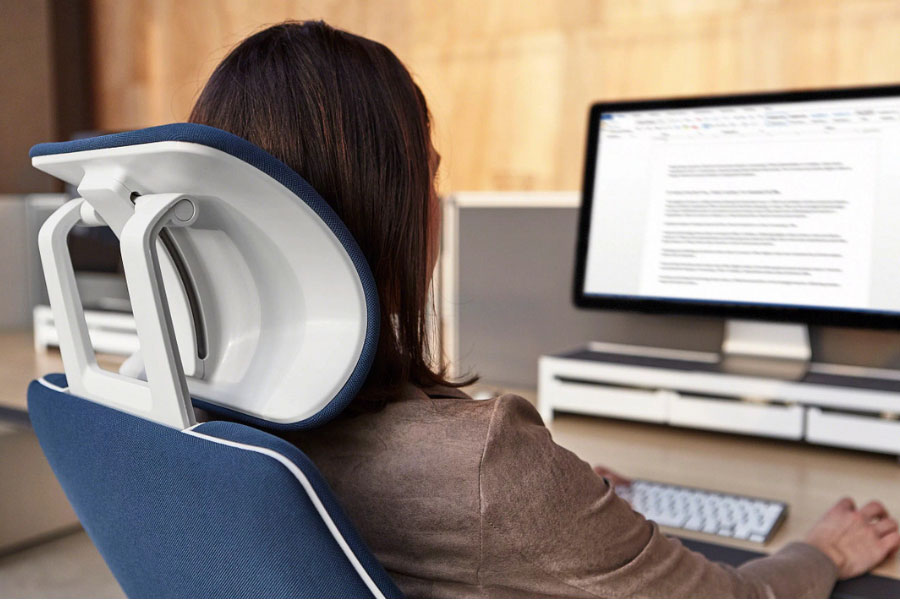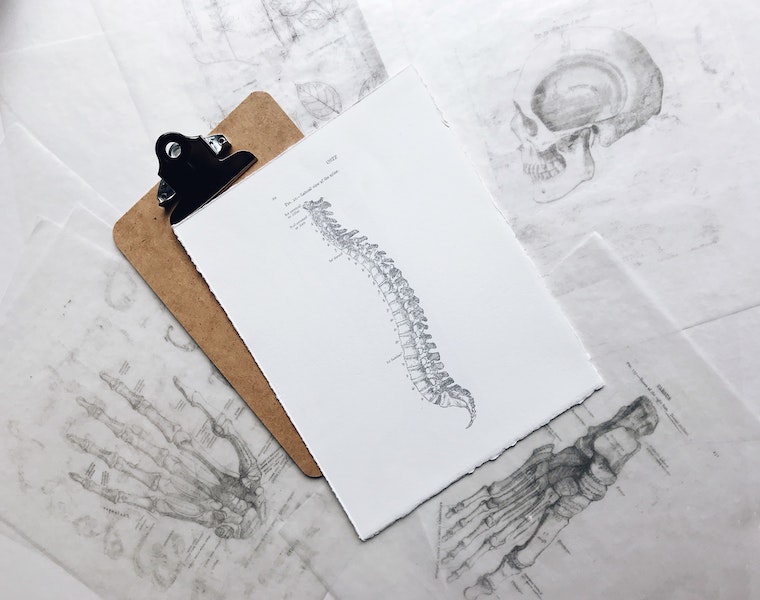Here, we share our expert tips on how to alleviate and prevent tech neck symptoms to create more comfortable, human-centric working environments that support physical and mental wellbeing.
Advice includes investing in ergonomic office furniture designed to nurture musculoskeletal health and promote diverse postures and seating positions throughout the day.
What is tech neck and what are the symptoms?
‘Tech neck’ is a phrase that is becoming more and more prevalent in mainstream media headlines and medical thought-leadership pieces alike. It describes the detrimental stress on our necks, shoulders, backs and spines as a result of looking down at digital devices for long stints of time.
Experts say that looking down to scroll through phones and type on laptops, etc, in this way could be adding around 50 lbs of pressure to our necks.
This is causing a rise in things like neck spasms, sore shoulder joints, nerve issues, musculoskeletal problems and chronic headaches.
All of these physical health issues are arising because of the weight of pressure on the neck as it has to contract and work so hard to hold heavy heads in that downward position many of us are in for so long every day.
So, what can be done about it in the workplace?
Recline in your seat, don’t sit upright
World-renowned cervical spine surgeon, Dr. Daniel Riew, M.D., says that contrary to popular belief, we should be reclining in our seats, as opposed to sitting up straight.
Sitting at a 90° angle puts extra pressure on the discs in the lower spine, leading to pain in the lower back over time.
Sitting upright also causes the neck to become overworked as it has to take the entire weight of holding the head up. If you’re doing this for long periods of time, it can result in ongoing pain in the neck, shoulders, back and even the head—all the systems of tech neck many of us will be able to recognise.
“Most people have been told to sit up straight when working on a computer. I’ve heard that advice given by doctors, therapists, and other experts. Unfortunately, this is incorrect advice.”
So, when it comes to selecting office furniture for your workspace, invest in ergonomic office chairs that are designed to recline.
This could be by a weight-activated mechanism or using a lever—either way, give space-users the chance to recline while they work and use their digital devices throughout the day, rather than sitting upright in non-adjustable chairs for prolonged periods of time.
Sit at a 20-30° recline angle
Dr. Riew recommends that reclining at a 20-30° angle is the optimum sitting position to prevent tech neck symptoms from occurring and developing. This allows for the chair to take some of your body weight, rather than in being held up by the spine and neck muscles.
According to Riew, if you were to fall asleep in your office chair or completely relax your body, your head should be able to roll backward rather than forwards. Test your seating position out and adjust your chair accordingly until you’ve achieved this optimal posture.
Invest in high-quality lumbar support
As well as opting for ergonomic office chairs for your workspace that allows the user to recline at a comfortable 20-30° angle, also look out for high-quality lumbar support.
This works by closing the gap created between the curvature of the spine and the back of the seat when somebody sits on it. This is available in varying degrees of support, depending on the chair you choose.
Good lumbar support will help maintain the natural arch of the back, which takes the pressure off the spinal discs and prevents problems from arising in the lower back. It also stops the spine from having to work so hard to hold the body up and as a result reduces pressure on the neck and head too.
You can purchase separate lumbar support products to add to existing office chairs but it offers a more polished and streamlined finish if you can find chairs that have this feature in-built.
Consider the benefits of height-adjustable furniture
In order to take a lot of the pressure off the neck when using devices, it’s important to encourage more postures that allow the head to face forwards rather than look down.
A great way to support this is by installing height-adjustable, sit-stand desks that allow the workstation to be raised to a comfortable level for the user.
If new sit-stand desks aren’t within your budget right now, speak to a workspace expert to discuss alternative options.
There is a selection of different office supplies and desk accessories (such as laptop stands) designed to raise digital devices to eye level and support standing work without having to overhaul your existing furniture portfolio.
Encourage multiple postures throughout the day
The typical human body is made up of around 206 bones and over 600 muscles, which means it is capable of a whole plethora of different postures and positions.
We’re not suggesting you have to contort yourself into downward dog or reclined pigeon while you work but it is physically (and mentally) beneficial to switch up how you sit (or stand) throughout the day.
The spine is naturally S-shaped so furniture and an office environment that limits mobility can cause problems like those related to tech neck. Offering a range of different work settings, types of furniture and levels of work surface is a great way to get employees to change posture as many times as possible during the day.
Offer a mixture of soft and hard seating, low and high surfaces, indoor and outdoor spaces—just some examples of how you can encourage different postures to reduce prolonged periods of pressure and contraction in the neck and spine.
You could even consider a spot of desk yoga between meetings to get the blood flowing and keep your joints nice and loose.
Promote less sedentary behaviour in the workplace
One of the most effective ways to prevent and reduce the symptoms of tech neck and the physical consequences of prolonged periods of sitting at desks using devices is to move more.
Of course, with busy schedules and never-ending to-do lists, this can feel tricky. However, if you can encourage and facilitate more movement during the working day, lifestyles naturally become less sedentary.
Some simple ways to promote more physical activity in the workplace include:
- Diverse work settings that encourage mobile and agile ways of working so employees aren’t tethered to technology for too long.
- Height-adjustable furniture such as sit-stand desks.
- Furniture on wheels to promote reconfiguration and agility.
- A hybrid working model so employees have more time to get movement in during the day.
- An office gym or yoga studio.
- Staff perks dedicated to physical exercise, such as a gym membership or cycle-to-work scheme.
More reading: How employers can promote less sedentary lifestyles >>




